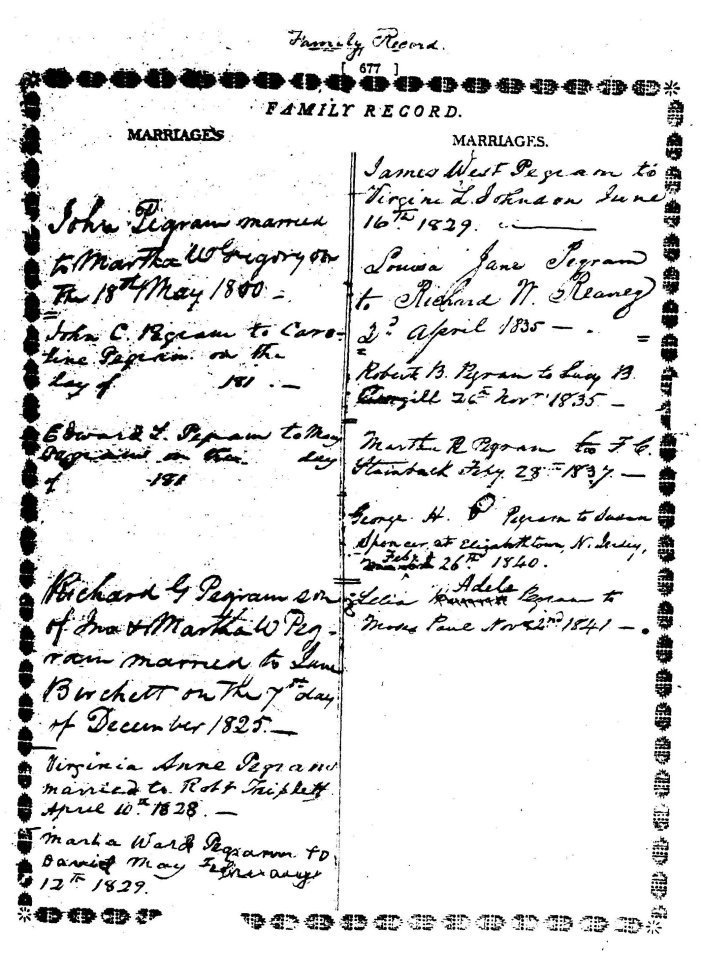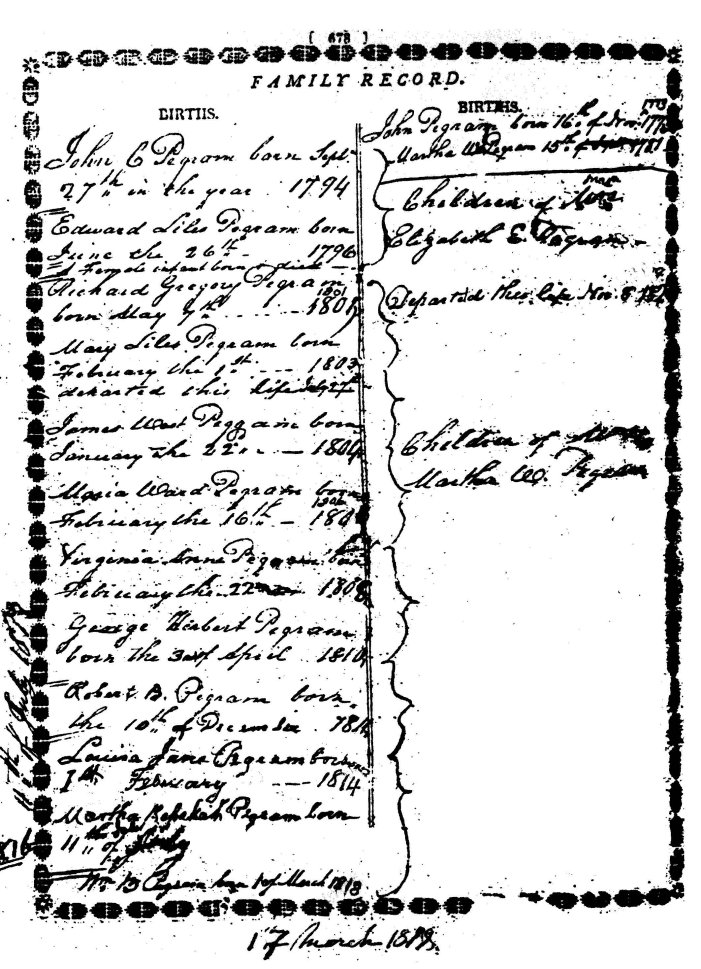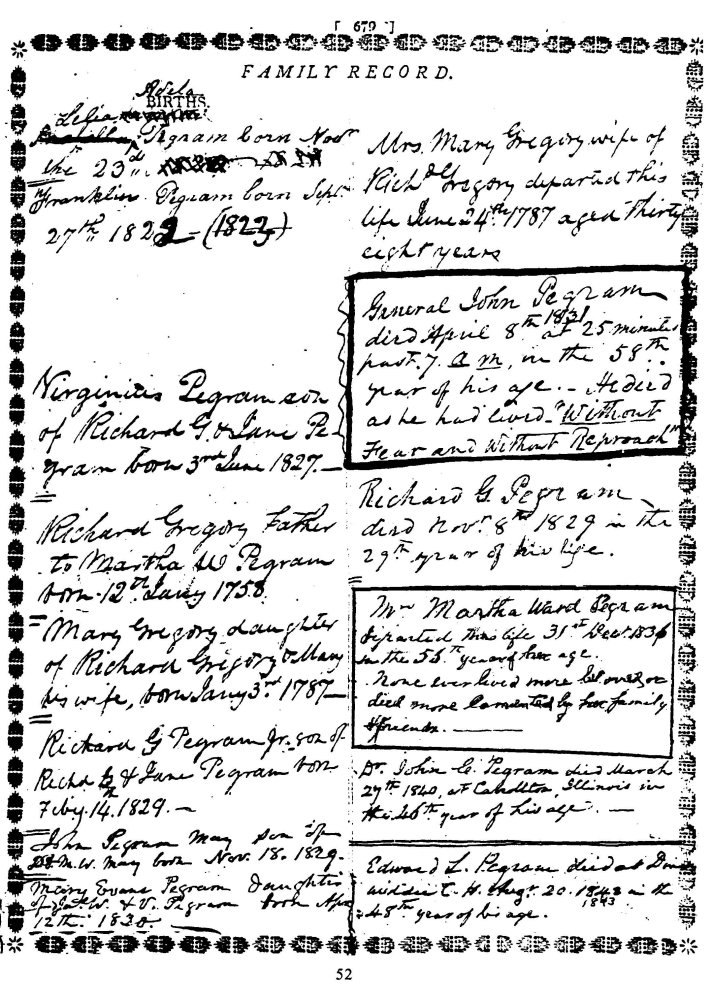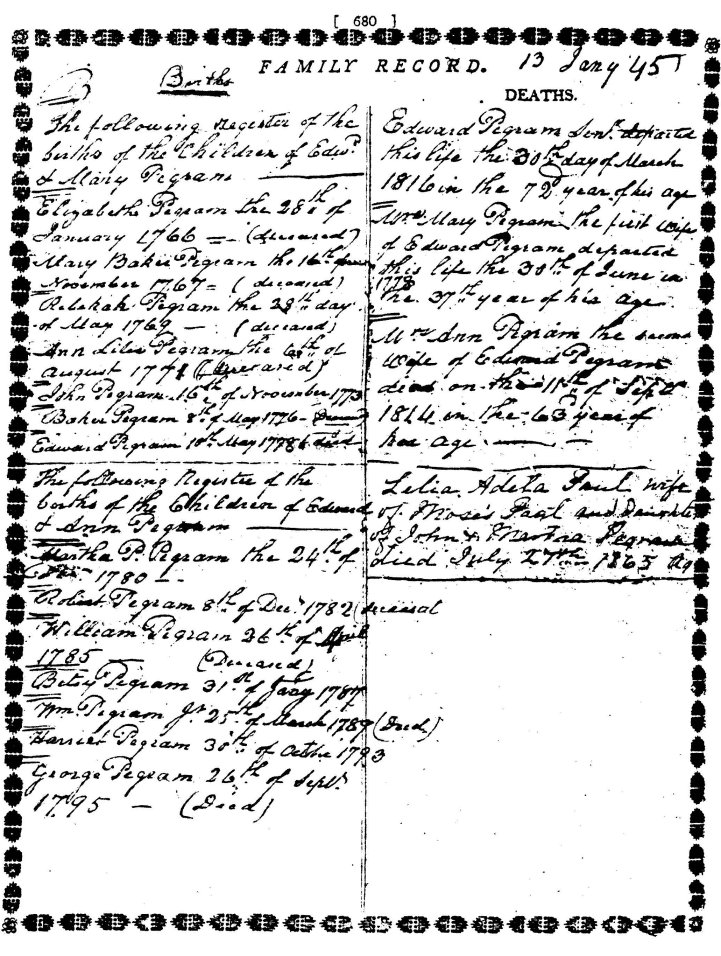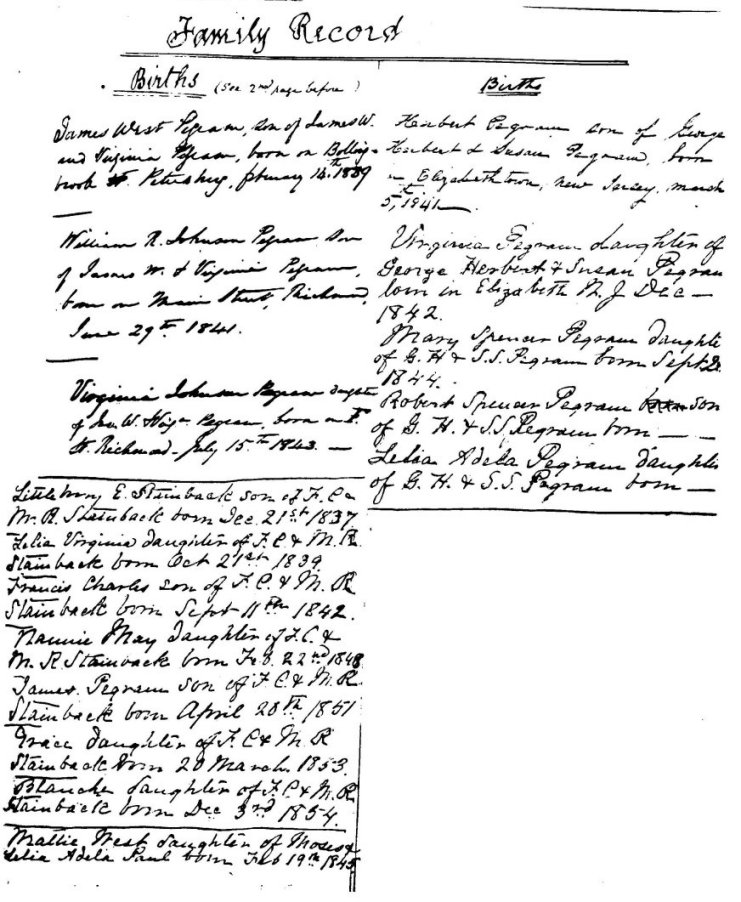|
|
|||||||||
|
|
10 MAJOR GENERAL JOHN PEGRAM5
The life of General John Pegram and his distinguished descendants deserve a separate volume to do justice to this branch of the family. This particular treatise, as noted in the preface, emphasizes the lineal descendants of Daniel Pegram4, son of Edward3 and Mary Scott Baker; with collateral branches being included to the extent feasible with the information at hand. In the case of General Pegram, essentially a resume of the information available on him and his descendants in the published literature, and other documents at hand, are included. References in the literature regarding him may be found in the Virginia Historical Index (1), The Biography and Genealogy Master Index (3), and other genealogical indices. General Pegram was a Gentleman Justice of Dinwiddie County, as were a number of other members of the Pegram family. He was a large land and slave owner. Some of the land that he owned during the period 1794 -1819 is listed in "Land Records of Dinwiddie County" (42). John succeeded Peterson Goodwyn as sheriff of Dinwiddie County, as shown by a plaque hanging in the sheriff's office covering the period 1763-1972, also references (49, 50). He was in the Virginia House of Delegates from 1797-1801. He served in the Virginia Senate from 1804 to 1808 or 1812, and was in the Assembly again from 1813 to 1815 (40, 50). While in the Virginia Assembly, John voted to oppose the Alien and Sedition Law as violating the Bill of Rights (51). He also signed a petition in the Assembly to make Christianity the Religion of the country. John Pegram was a Brigadier General in the Virginia Militia in 1808, as shown by a letter which he wrote to the Governor of Virginia on 6 December of that year. The letter concerned military affairs of the fifteenth Brigade. He mentioned that Captain Pegram had made a tender of the services of his troop of horses, but stated that their guns and swords were in poor condition. Captain Pegram could be any one of a number of relatives, since most of them 1831, from a painting. held officer rank at one time or another. Like his neighbor and kinsman General Winfield Scott, John Pegram5 gained fame in the War of 1812, attaining the rank of Major General of the First Division of Virginia Militia. He was appointed United States Marshall for the Eastern District of Virginia by President Monroe (64, 66, 77). 43 Pegram was very active in the political, religious and
military affairs of Virginia. He held a number of positions of trust and honor. A major contribution of General John Pegram and both of his wives was their distinguished descendants, (62, 68). John and Elizabeth Coleman had but two children prior to her death in 1787. They were JOHN COLEMAN, M.D.6, and Major EDWARD LYLE. JOHN COLEMAN PEGRAM, M.D.6 was born in Dinwiddie County 27 September 1794, and died March 27, 1890 in Carrollton, Illinois. He was a graduate of the Philadelphia Medical College, class of 1815 (41). He was a Vestryman of Bristol Parish (68), and was Justice of the Dinwiddie County Court, 1826-29. Dr. Pegram married Caroline Pegram, daughter of George Pegram, and they moved to Carrollton, Illinois (6, 62, 68). They must have moved to Illinois after 1834 since their daughter Martha Ward was said to have been born in Dinwiddie in that year. On 12 August 1825 Boswell Hutchings, Cloverville, Dinwiddie County, wrote his brother William of Murfreesboro, Tennessee, giving him much news of Dinwiddie County. He stated that Colonel Robert Pegram had become a preacher of the Gospel, and that Dr. John Pegram had also become a Christian (39). Dr. John Coleman Pegram and Caroline had nine children as follows: GEORGE7, ELIZABETH EPPES COLEMAN, BENJAMIN RUSH, JOHN, EDWARD, MARIA VIRGINIA, MARY CAROLINE, CHARLES JAMES and MARTHA WARD. Each individual, followed by his or her descendants, is treated below, according to age seniority. CAPTAIN GEORGE PEGRAM7 was born in Dinwiddie County 26 December 1815. He moved to Carrollton, Illinois, with his parents. He first married Mary Catherine Andrews at Carrollton. She was the daughter of Mary Peter Pegram and Baker Andrews, and was born in Dinwiddie County 29 January 1823. George moved from Illinois to St. Louis, Missouri. Mary, his wife, died there in November 1856. George afterwards married Harriet Howard, nee Bryan, who was a sister of Mrs. M.J. Pegram of St. Louis. George's second wife died, and he married Mrs. Mary A. Bailey of St. Louis on 19 January 1876. George died in St. Louis 27 April 1877. George was a successful entrepreneur in a variety of businesses. He was a merchant, a flour manufacturer, and steamboat builder, owner and operator. His firm operated three of the largest flour mills in St. Louis, and a fleet of steamers on the lower Mississippi River. He designed and built the first steamer to carry 1,000 tons in only six feet of water; a design quickly copied by other builders. The Atlantic and Mississippi Steamboat Company was inaugurated in 1866 with 28 steamboats, the finest ever consolidated on the river, and valued at $2,500,000. George Pegram7 was a principal stockholder. The impoverishment of the South following the Civil War paralyzed trade. Several of the boats were lost by fire and explosion. Finally the company was forced to sell the fleet at auction to pay indebtedness. It was said that George was a man of large caliber,
indomitable pluck, a great organizer, and regarded as a "commercial commodore."
He had a cheerful disposition, and was loved by all of his employees (45). His
children are listed below:
By Harriet Howard:
ELIZABETH EPPES COLEMAN PEGRAM7, daughter of Dr. John Coleman Pegram and Caroline Pegram, was born in Dinwiddie County. She married Benjamin William Andrews, a brother of Baker Andrews, the husband of Mary Peter Pegram, the daughter of Baker Pegram4 and Mary Manson. They moved to Christian County, Kentucky. There was one daughter, LELIA8, born 1 December 1841. Elizabeth Pegram died in Carrollton, Illinois in 1843. BENJAMIN RUSH PEGRAM7, son of Dr. John Pegram and Caroline Pegram, was born in Dinwiddie County 24 April 1818, and moved with his parents to Carrollton, Illinois. No doubt Benjamin's father named his son for the famous physician, Benjamin Rush, a signer of the Declaration of Independence. The Rush Medical College, now the Medical College of the University of Chicago, honored the Rush name. Benjamin Rush Pegram did not become a physician, but was a successful businessman. He married Mercy Adeline Robbins of Cohasset, Massachusetts. Benjamin Rush had a general store in Council Bluff, Iowa, and contracted for the transportation of goods across the plains, before there were railroads in the area. Benjamin moved from Iowa to St. Louis, Missouri, where his brother George was a successful business man. He became a steamboat captain of the largest freshwater steamboat in the country at the time. Like his brother George, he was an innovator. He and George designed and owned the boat which he captained. He devised the handling of stage planks by derricks, which was widely accepted. He was said to be the originator of turning steam into the vessel hold to extinguish a fire. Benjamin later became superintendent of the Water Lines of the Union Pacific Railroad Company's steamers, plying the Pacific, the Columbia and other rivers (45). Benjamin Rush and Mercy had the following children: GEORGE HERNDON', MINNIE STELLA and FRANK RUSH. GEORGE HERNDON PEGRAM8 (Benjamin Rush7, John Coleman6, John5, Edward4, Edward3, Daniel2, George1) was born in Council Bluff, Iowa 29 December 1855, and became one of the country's noted Civil Engineers. He was graduated C.E. from Washington University, St. Louis, Missouri in 1877, with the highest rating that had then been attained. His first position was with the Utah and Northern Railroad in Idaho. He became assistant to the noted bridge builder, Shaler Smith. He had many positions of rank and honor, among them: Chief Engineer of Edge Moor Iron Works, at the time the largest bridge works in the world. He resigned in 1893 to travel in Europe, and subsequently opened an office in New York. He was consulting engineer to many large corporations. He was chief engineer of the Manhattan Elevated Railroad and the Interborough Transit Company. In 1899 he patented the Pegram Truss for bridges. He designed and built the Kansas City elevated railroad in 1886;the combined railroad and highway bridge across the Ar- (69) 45 kansas River at Fort Smith, Arkansas; railroad bridges across the Ouachita, Little and Red Rivers in Louisiana; and the train house of the Union Station in St. Louis, which displayed a new type of large roof construction. In one season he rebuilt the over one mile long bridge over the Snake River in Idaho. He designed the six-foot diameter steel pipe line of the Pioneer Electric Power Company at Ogden, Utah. He obtained patents on the special machinery to rivet it up by power in the trench. In 1907 he completed the tunnel under the East River in New York, for the interborough Rapid Transit Company. He also handled many other large engineering projects. In 1931 he was appointed by the American Society of Civil Engineers to go to Russia to assemble information on opportunities for engineers in that country, for the members of the profession in the United States. He published a number of technical papers, was awarded honorary degrees, and served on, and was chairman of, many important committees and study groups. George Herndon married Jessie Merrielees Crawford of St. Louis in September 1897. They had three children: JEAN FORSYTH9, MERCY R. and GEORGE HERNDON Jr., who died in infancy. George Herndon Pegram8 died in Brooklyn, New York, 23 December 1937. A biographical sketch and portrait of him appears in The National Cyclopedia of American Biography (69), which presents more detail than can be included here. MINNIE STELLA PEGRAM8, daughter of Benjamin Rush Pegram and Mercy Adelaide Robbins, married Ferdinand J. Fabian. FRANK RUSH PEGRAM8, son of Benjamin Rush Pegram and Mercy Adelaide Robbins, was likely born in Council Bluff, Iowa. No information available. JOHN PEGRAM7 and his brother EDWARD, sons of Dr. John Coleman Pegram and Caroline Pegram, died of hydrophobia while young boys (45); one of the most tragic of deaths. MARIA VIRGINIA PEGRAM7, daughter of Dr. John Pegram and Caroline Pegram, was born in Dinwiddie County, Virginia, and moved with her parents to Carrollton, Illinois. She married Thornton Bostick of Scottsville, Illinois, on 21 April 1852, in St. Louis, Missouri. Maria Virginia died 4 September 1861, and is buried in Carrollton, Illinois. There were two children: ELIZABETH8, who was born 12 August 1855, and CARRIE PEGRAM, born 17 September 1858.
Mary Caroline and Dr. Russell moved to Hamilton, Illinois, where she died on 5 February 1890. They had six children: MARY CATHERINE8, JULIET F., JOHN PEGRAM, WILLIAM L., LAURA G. and JOSEPHINE. CHARLES JAMES PEGRAM7, son of Dr. John C. Pegram and Caroline Pegram, was born in Dinwiddie County, Virginia, and died in Carrollton, Illinois. MARTHA WARD PEGRAM7, daughter of Dr. John C. and Caroline Pegram, was born in Dinwiddie County 8 April 1834, and moved to Carrollton, Illinois with her family. She married William Alexander Pegram6, son of William Baker Pegram5 and Sarah E.M.J. Walker, on 3 July 1849. She died at Lincoln, Illinois in 1877. There were twelve children (See male line). MAJOR EDWARD LYLE PEGRAM6, second son of General John Pegram and Elizabeth Eppes Coleman, was born in Dinwiddie County 26 June 1796, and died there 20 August 46 1843. He married MARY PEGRAM, daughter of George Pegram (62). Edward Lyle was a 1st Lieutenant, 35th. Infantry on 31 March 1813; disbanded June 1815 (92). He later attained the rank of Major. He was a lawyer by profession. Edward Lyle and Mary Pegram had five children: ALGENON7, RICHARD, LAURA, VIRGINIA JANE and MATILDA. ALGENON PEGRAM7 was a lawyer. A.T. Pegram, son of Edward L. Pegram, was registered as a student at William and Mary College in the session of 1838-39. He entered October 9 at the age of 17 as a regular junior. He lived at the home of Dr. John M. Galt in Williamsburg. A.T. was most likely ALGENON; however, the initials are not certain. He is listed in another source as ALGENON S. (45, 75). RICHARD PEGRAM7, son of Edward Lyle Pegram and Mary Pegram, was born in Dinwiddie County. He was a physician. He married Miss Saunders, daughter of Professor Saunders of Virginia. Dr. Pegram moved to California, where he died. His body was brought back to "Diamond Springs", Dinwiddie County, for burial. LAURA PEGRAM7, daughter of Edward Lyle and Mary
Pegram, was born in Dinwiddie County. She married a Dr. Hamilton of Mississippi. MATILDA PEGRAM7, daughter of Edward Lyle and Mary Pegram, was born in Dinwiddie County. She married John A. Brander, at the home of her parents on 4 November 1835, as recorded in the Reverend John Cameron's Register and the Bath Parish Register. (Va. Genealogical Soc. 1963). Matilda's (or Martha's) funeral was held 15 November 1836, at the home of her parents in Dinwiddie County. She lived only a year after her marriage. She and John had a daughter, MATILDA8, who married Dr. Benjamin Wilkins. They moved to California and had two children, BENJAMIN9 and MATILDA. After the death of his first wife, Elizabeth Eppes Coleman, General John Pegram' married Martha Ward Gregory, daughter of Richard Gregory and Mary Ward, on 18 May 1800. She was born 15 September 1781, and died 31 December 1836. Richard Gregory was a prominent lawyer in Chesterfield County, Virginia. Mary, his wife, was the daughter of Colonel Seth Ward, a member of the House of Burgesses, who died in 1769. The Ward family was one of the very early and influential families of Virginia, the history of which has been recorded in a number of documents (70). "Bonneville", the home built by General John Pegram near the village of Dinwiddie was, according to tradition, built for his new bride. The owners of "Bonneville" in 1980, the Knott family, who had lived there for eighty-five years, related the story again. The date 1800 is on the chimney near the top of the gable. It appears therefore that the story is a true one, especially since John married in 1800. "Bonneville" was visited by the compiler in November 1980. It was occupied and in a good state of repair. The house was built near a large spring which supplied water for the household. The spring was used by soldiers of both the North and South during the battle of Chamberlayne's Bed, or the battle of Dinwiddie Courthouse, fought 31 March 1865. Part of the battle was fought on the land surrounding "Bonneville". The Confederate The Confederate flanking attack against Sheridan's caval- 47 ry corps trapped several Union soldiers on the upper floor, and they were killed. Musket balls were embedded in the house during the battle, and were dislodged when the home was renovated about 1900. Some of the fighting around "Bonneville" has been referred to as the battle of Pegram Farms. Numerous relics of the battle, such as old muskets, bayonets and cannon balls have been unearthed on the farm during cultivation. From Dinwiddie Courthouse "Bonneville" is Northeast on U.S. No. 1, 2/10 mile, then 1 2/10 miles North on route 627, then West on a private road for 4/10 mile. "Bonneville" is a frame house.
The house now contains 14 rooms. The doors have six sections, forming a cross to keep out the witches, a superstition; also used in other Manor Houses of the area. The Southside Virginia News published an article, 16 February 1967, entitled "Bonneville Plantation Rich in History". The article includes an aerial photograph of the house and accompanying outbuildings, as well as photographs of the interior. It showed an old schoolmaster's desk, believed to be one of the first used in America. The article is too lengthy to include here, and the illustrations are not suitable for reproduction. The Works Progress Administration prepared a special report on "Bonneville" in 1937, which gives much detail including historical and architectural information. The aerial photograph shows an area to the right of the house that is enclosed by a stone masonary wall. This was said to be the family graveyard. When I visited there in 1980, Mrs. Simmons and I were shown about the place by Mr. Willie B. Knott, the owner. He stated that Mr. Robert B. Pegram of Atlanta, Georgia, a descendant of General Pegram and Martha Ward Gregory, had made special efforts to locate Pegram gravesites, especially that of Edward Pegram3. He had the enclosed area dug up but found nothing. Mr. Knott believed that the wall was a foundation for an early building, perhaps a large detached kitchen or smokehouse. This appears logical. No family graveyard has been found at "Bonneville", although many Pegrams have been buried in established graveyards, of the area. The article in the Southside Virginia News was thus probably in error relative to the graveyard, but the enclosed area was likely considered as such for many years. In addition to the date of 1800 on the chimney of "Bonneville", the bricks bear the initials W.E. The same initials are on the bricks at "Ridgeway", indicating a common builder, or a common brickmaker (40). "Ridgeway" was the home of Thomas Thweatt, and was built about 1812. General John Pegram died in 1831. "Bonneville" was sold by Commissioners, by virtue of a decree in Chancery of the County Court of Dinwiddie, made at the February term of court in 1837, in the case of George H. Pegram and others against James Pegram and others. James M. Pegram and David May purchased "Bonneville" at that time. James Pegram and wife and David May and wife, who were heirs, sold "Bonneville" to Abner Adams in 1839. It is believed that the James M. Pegram was actually James W. or James West Pegram, a son of General John. David May was General John's son in law. "Bonneville" remained in the Adams family until 1895, when it was sold to William W. Knott. All of the various heirs of Abner Adams and William W. Knott who have been concerned in the transfer of title of "Bonneville" at various times are named in a deed on file in the Dinwiddie County Clerk's office (71). Willie B. Knott owned the place in 1980, but in 1981 it was placed on auction, and probably now has a new owner. When Mr. William W. Knott acquired the place it contained 1000 acres. Much of this was subsequently sold, and homes built on it. "Bonneville", the house, will probably remain for a long time, but "Bonneville" the plantation is gone forever, along with its people who lived and loved and laughed and died, and who helped to make history, when this country was young, and so desperately needed men and women of their stature to mold what was to be. 48 General Pegram and his wife Martha Ward Gregory lived in the style of the affluent plantation owners of that time and place. The 1830 census showed that General Pegram owned forty slaves. Dinwiddie County seemed to have more than its share of wealthy and prominent landlords. Most of them were also prolific in producing large families, and why shouldn't they? It was expected that their offspring would enjoy the same affluence and prestige as themselves, in this promising new country. This did happen for a time, but as the farm land wore out, for lack of crop rotations, fertilizer and erosion control, many of their descendants moved on to new areas, especially North Carolina and Tennessee. Many failed to attain the affluence that they left in Virginia. The wealthy slave and land owners of the turn of the century did not know that 60 years later their new nation would be divided against itself, and that one of the most savage wars of modern times would forever doom the way of their life and that of their descendants. General John Pegram lived a useful and noble life, as exemplified by the many obituaries following his death. He was a man of whom it was said he was: "active and useful, disinterested, and patriotic, fearless and lofty, and with a chastity of honor which felt a sting like a sword" (32). He is listed in Clemen's "Famous Virginians" (67). The following Memorial from the Richmond Enquirer must have been written long after General Pegram's death. The date of death is in error. Many sources, including his family Bible, list the death as 8 April 1831.
Ambler Moncure wrote a biographical sketch of General John Pegram in the Dinwiddie County News, Lawrenceville, Virginia, 2 February 1928; thus the General still lives in the memory of his countrymen. The following is a reproduction of family records from General Pegram's bible (62). These were obviously augmented by his descendants during the years following his death. 49
|
|
|
|
50 |
|
|
|
51 |
|
|
|
|
|
53 |
|
|
|
54 |
|
General John and Martha had twelve children, namely: RICHARD GREGORY6, MARY LYLE, JAMES WEST, MARIA WARD, VIRGINIA ANN, GEORGE HERBERT, ROBERT BAKER, LOUISA JANE, MARTHA REBECCA, WILLIAM B., LELIA ADELA and FRANKLIN. A number of these deserve special consideration. All are discussed in order of seniority. CAPTAIN RICHARD GREGORY PEGRAM6, first child of Gen. John and Martha, was born 7 May 1801 at "Bonneville", and died 8 November 1829 in Dinwiddie County. His obituary appeared in the Richmond Whig of 11 November 1829. Richard Gregory married Jane Brichett, 7 December 1825, daughter of Robert Brichett, a lawyer and a Whig. Richard and Jane had two sons:
MARY LYLE PEGRAM6, daughter of General John Pegram and Martha Ward Gregory, was born in Dinwiddie County 1 February 1803, and died 27 July 18--. 55 |
| Back | Next | Index | Table of Contents | References | |
